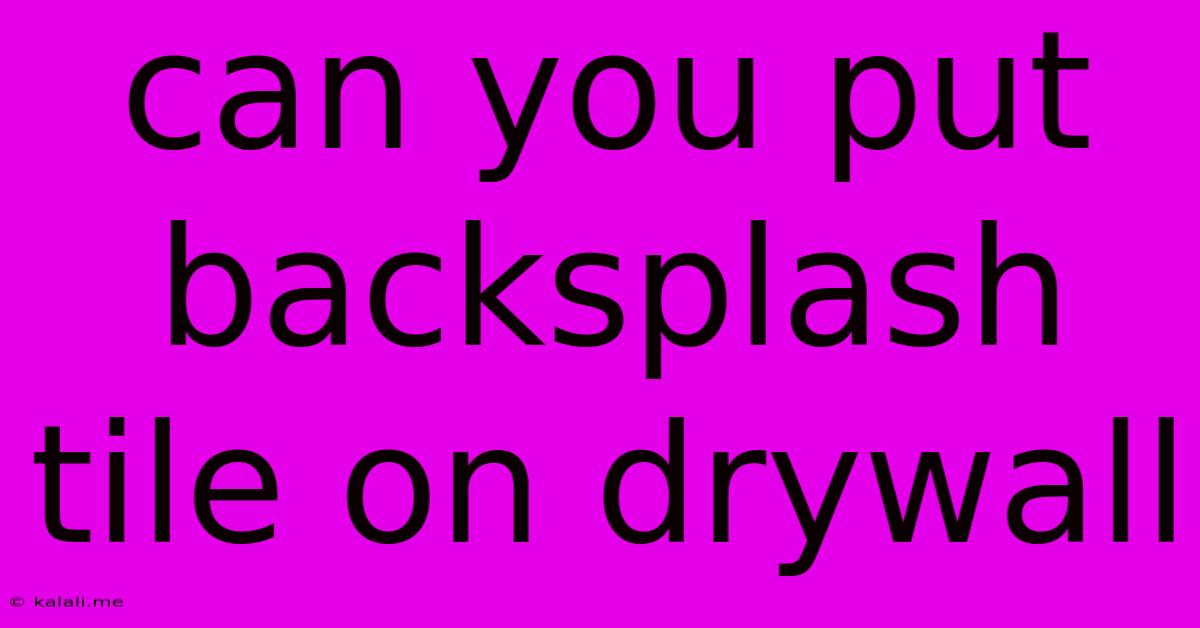Can You Put Backsplash Tile On Drywall
Kalali
May 28, 2025 · 3 min read

Table of Contents
Can You Put Backsplash Tile on Drywall? A Comprehensive Guide
Meta Description: Wondering if you can tile directly onto drywall? This comprehensive guide explores the feasibility, challenges, and best practices for installing a backsplash tile on drywall, helping you make an informed decision for your kitchen or bathroom renovation.
Installing a backsplash is a fantastic way to update your kitchen or bathroom, adding both style and protection. But before you start shopping for those beautiful tiles, a crucial question arises: can you put backsplash tile directly on drywall? The short answer is: it's possible, but not always recommended. This guide will delve into the pros, cons, and best practices to help you make the right choice for your project.
Understanding the Challenges of Tiling on Drywall
Drywall, while a common building material, isn't ideal for all tiling projects. Its porous nature and relative weakness compared to other substrates can lead to several issues:
- Moisture Damage: Drywall is susceptible to water damage, especially in high-moisture areas like bathrooms. If water seeps behind the tiles, it can lead to mold growth, warping, and costly repairs.
- Lack of Stability: Drywall isn't as strong as cement board or other tile backer boards. Heavier tiles or large format tiles might not adhere properly, leading to cracking or tiles falling off over time.
- Uneven Surface: Even seemingly smooth drywall can have slight imperfections that will show through the thinset and grout. This can lead to an uneven and unprofessional-looking finish.
When Tiling Directly on Drywall Might Be Acceptable
There are situations where tiling directly onto drywall might be considered, but with significant caveats:
- Lightweight Tiles: If you're using very lightweight tiles, such as small mosaic tiles, the risk might be lower. However, proper preparation is still crucial.
- Small Areas: For a small backsplash area with minimal water exposure, and using lightweight tiles, the risk might be lower, but always use a good quality tile adhesive.
- Existing, Sturdy Drywall: If your drywall is exceptionally strong and well-attached to the studs, and is in perfect condition, you might get away with it. However, it's always a gamble.
Best Practices for Tiling on Drywall (If You Choose To)**
If you decide to proceed with tiling directly onto drywall, these steps are crucial to mitigate risks:
- Proper Surface Preparation: Thoroughly clean the drywall surface, removing any dust, debris, or loose particles. Prime the area with a high-quality acrylic primer specifically designed for tile applications to enhance adhesion and create a moisture barrier. Repair any cracks or imperfections with drywall compound. Sand smooth and prime again.
- Choosing the Right Adhesive: Use a modified thin-set mortar specifically formulated for tiling over drywall. These modified mortars provide better adhesion and flexibility than standard thin-set.
- Thinset Application: Apply the thinset mortar to both the back of the tile and the drywall using a notched trowel, ensuring good coverage and eliminating air pockets.
- Tile Spacing: Maintain consistent spacing between tiles using spacers to achieve a professional look.
- Grouting: After the thinset has fully cured, grout the tiles, cleaning excess grout promptly.
The Safer and More Recommended Approach: Using Backer Board
For the vast majority of backsplash projects, using a cement board like WonderBoard or Hardibacker is strongly recommended. These products are specifically designed for tiling, offering superior moisture resistance, stability, and a solid base for your tiles. They offer superior protection against water damage and cracking compared to direct application onto drywall. Installing backer board adds a small amount of additional work, but it significantly reduces the risk of future problems and ensures a long-lasting, beautiful backsplash.
Conclusion
While it's technically possible to tile directly onto drywall, it's often not the best approach. The potential for moisture damage, cracking, and other issues outweighs the convenience in most cases. Investing the extra time and effort to install a cement backer board is a much wiser decision that will protect your investment and provide a more durable and aesthetically pleasing backsplash for years to come. Always prioritize proper preparation and the use of high-quality materials for a successful tiling project.
Latest Posts
Latest Posts
-
What Is The Highest Number In The Universe
May 30, 2025
-
Check If The Ratio Is 1 Hypothesis Testing
May 30, 2025
-
Why Does Opening Data As Csv Go To Numbers Mac
May 30, 2025
-
Difference Between Chicken And Hen And Rooster
May 30, 2025
-
The World Is Your Oyster Origin Meaning
May 30, 2025
Related Post
Thank you for visiting our website which covers about Can You Put Backsplash Tile On Drywall . We hope the information provided has been useful to you. Feel free to contact us if you have any questions or need further assistance. See you next time and don't miss to bookmark.